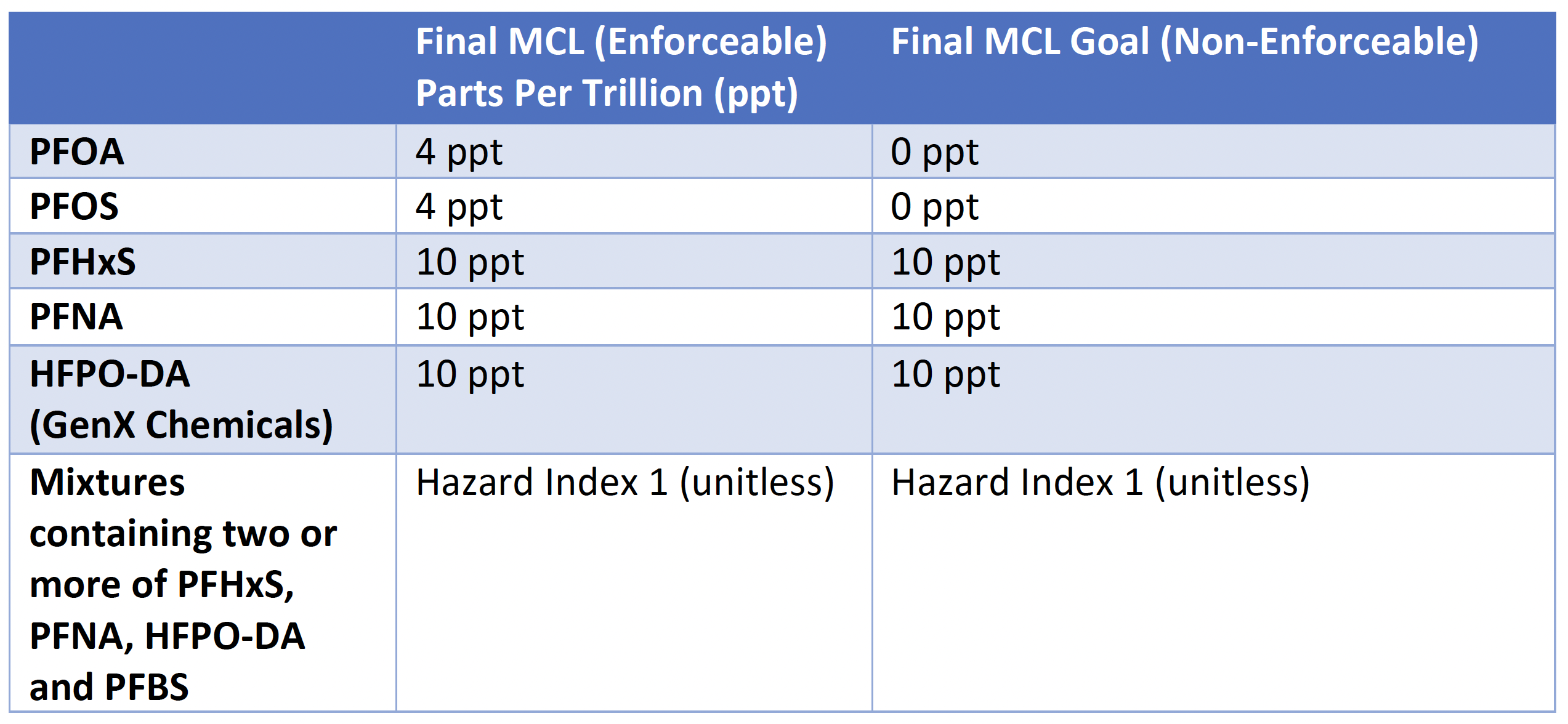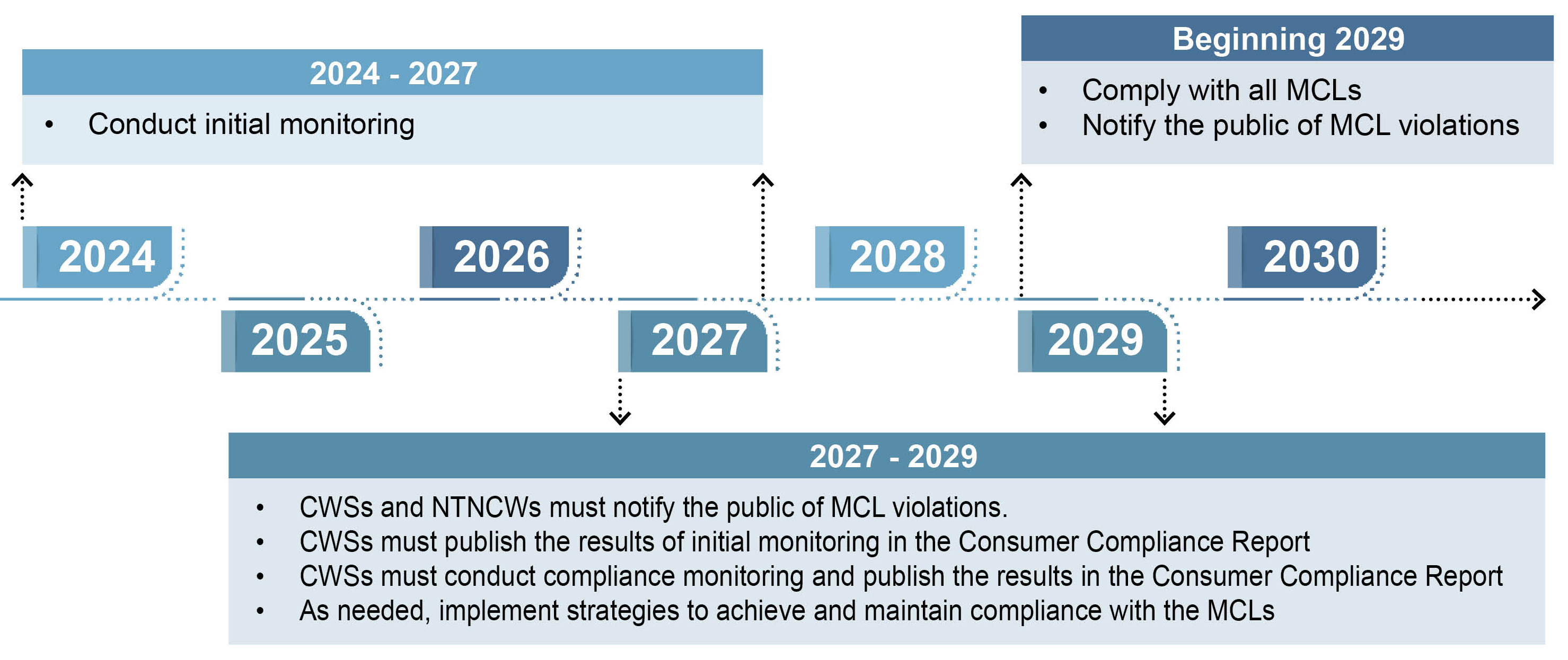EPA Sets Stringent Federal Drinking Water Limits for PFAS: Major Challenges and Costs to Follow for Drinking Water Suppliers, Big and Small
Alerts
April 26, 2024
The US Environmental Protection Agency (EPA) recently published a final rule creating a legally enforceable drinking water standard for six per- and poly-fluoroalkyl substances (PFAS) under the Safe Drinking Water Act (SDWA) that will affect millions of people and thousands of schools, landlords, manufacturing facilities and other entities across the country. Individual states may also regulate PFAS in drinking water but any standards for these 6 PFAS must be at least as stringent as these new federal standards, although we expect some states may set lower standards.
While the rule specifically addresses some PFAS in drinking water, it will have a wide- and far-reaching impact with respect to the regulation of PFAS generally, particularly as EPA and state environmental agencies are likely to rely on the new drinking water standards as support for regulating PFAS in other contexts. In addition, the new rule will continue to spur PFAS-related litigation.
For those that are unfamiliar, PFAS are thousands of “emerging contaminants” at the center of increasing health and environmental concerns. PFAS have been commonly used in numerous commercial and industrial applications where their resistance to water, heat and stains are beneficial. As result, PFAS have become ubiquitous in the environment and are now commonly detected in drinking water globally. Until now, PFAS in drinking water was regulated by an incomplete and inconsistent federal and state-by-state patchwork of regulation and non-enforceable administrative guidance.
The New Federal Standards
Under the SDWA, the EPA has set the first federally enforceable standards for six PFAS and certain PFAS mixtures in drinking water with stringent maximum contaminant levels (MCLs) and MCL Goals (MCLGs) (see table below). These near-zero standards and goals represent the lowest concentrations at which labs can reliably measure these substances in water. Notably, important aspirational MCLGs for PFOA and PFOS are zero as EPA maintains there is no “safe” level of consumption.

The final rule partially mirrors EPA’s proposed rule published in March 2023 with some key adjustments, particularly the addition of dedicated MCLs and MCLGs for PFHxS, PFNA and HFPO-DA (a/k/a GenX) and a “hazard index” for mixtures containing two or more of PFHxS, PFNA, HFPO-DA and PFBS.
Drinking Water Suppliers – Not Just Large Utilities!
The new rule will apply to two of the three classes of “Public Water Systems” (PWSs) regulated under the SDWA: (i) Community Water Systems (CWSs) that serve at least 25 year-round residents or 15 connections used by year-round residents; and (ii) Non-Transient Non-Community Water Systems (NTNCWs) that serve at least the same 25 people for at least 6 months per year. Notably, CWSs and NTNCWs include large public utilities as well as certain schools, factories, office buildings, strip malls and hospitals in suburban and rural communities that operate their own drinking water wells.
Importantly, excluded from compliance with the new requirements are: (i) private single-family residential wells (which are not PWSs under the SDWA); and (ii) Transient Non-Community Water Systems (TNCWSs) that serve at least 25 people but not necessarily the same people, e.g., certain restaurants, gas stations, parks, campgrounds and RV parks.
Staggered Implementation for Sampling and Mitigation
CWSs and NTNCWs subject to EPA’s new requirements must perform the following within the timeframes noted:

Notably, the regulations do not specify any particular methods for removing PFAS from drinking water, so regulated PWSs will have flexibility to use treatment technologies currently available and/or under development for point-of-entry or point-of-use removal (e.g., granular activated carbon filtration, nanofiltration, reverse osmosis, anion exchange systems). Regulated PWSs may also blend water sources to reduce PFAS concentrations or pursue developing a new water source.
Preparing for PFAS Regulation
Under existing SDWA regulations, regulated PWSs are already required to comply with MCLs and other standards for a variety of constituents of concern, including certain metals (e.g., lead, copper, arsenic), chemicals (e.g., nitrate, nitrite) and microbials (e.g., total coliform). PWSs now have an opportunity, with this new PFAS rule, to assess their overall operating procedures and compliance with the SDWA, including with respect to these “traditional” contaminants.
However, the new PFAS rule is a significant departure from existing SDWA requirements because the PFAS enforceable standards are so low (nearly non-detect) and the cost of mitigating even slight MCL exceedances will be so high (estimated in the billions per year nationally).
To jumpstart this effort, CWS and NTNCWs should consider developing a risk management plan specific to their water source, operations and potential PFAS-related risks and liabilities including, not only compliance with applicable regulatory requirements, but also evaluating potential third party claims.
In addition, it is critical for municipalities, manufacturers (including producers of foods and beverages that use water as an ingredient or in their processes), retail or multi-family housing owners and other regulated entities to evaluate their drinking water source and the potential risks related to PFAS generally.
In light of the evolving regulatory framework related to PFAS and the ever-increasing threat of PFAS-related litigation, any internal risk assessment should be carefully conducted through in-house or external legal counsel.
Funding PFAS Investigations and Mitigation
Under the Bipartisan Infrastructure Law, the state-implemented Emerging Contaminants in Small or Disadvantaged Communities Grant Program will distribute $1 billion to help defray the costs of initial PFAS testing and treatment. Additionally, PWSs may be able to benefit from the $12 billion available through other EPA programs, e.g., the Justice40 Initiative, which are intended to help communities make general drinking water improvements, including tackling PFAS contamination. There also may be state-level funding available to certain PWSs, including those operated by municipalities.
Lastly, additional funds may become available for PWSs that opted-in through landmark settlements totaling over $11 billion (and counting) in litigation against 3M, DuPont, Chemours and other PFAS manufacturers related to drinking water contamination across the country.
For any questions regarding PFAS, please visit Shipman's PFAS Resource Center or contact a Shipman environmental lawyer for more information. Our team advises national and international clients in real estate, manufacturing, agricultural, education and other sectors on the potential legal and technical impacts of PFAS on their business operations and/or transactions, as well as assisting in the development and implementation of PFAS-related risk management strategies.
